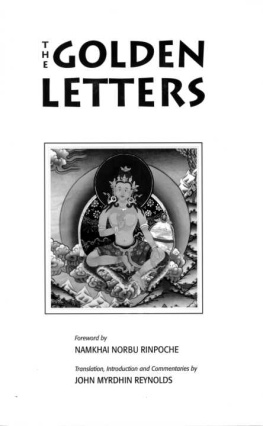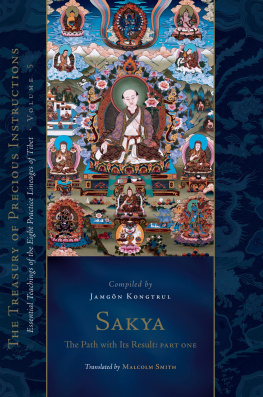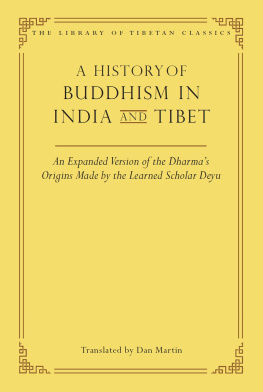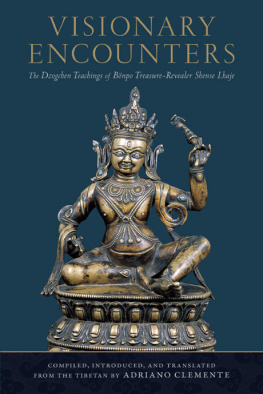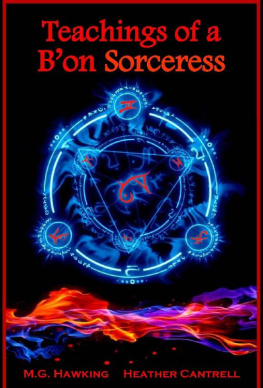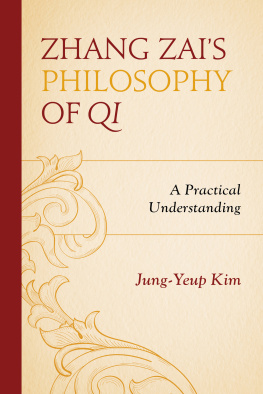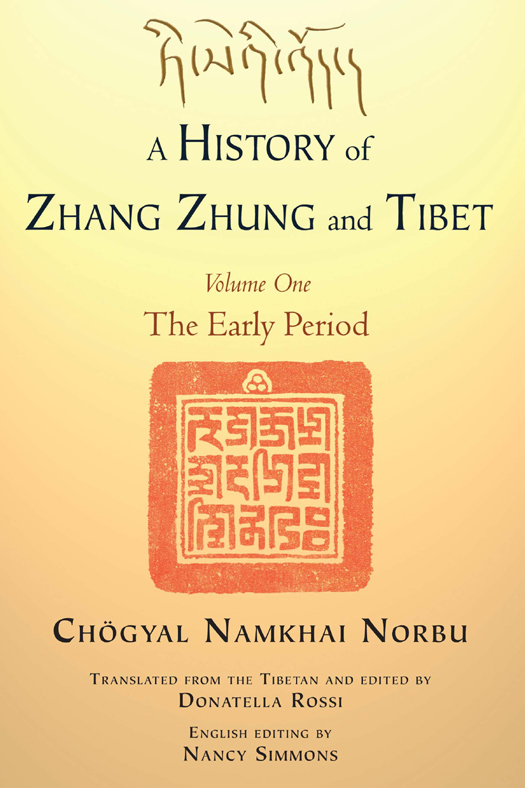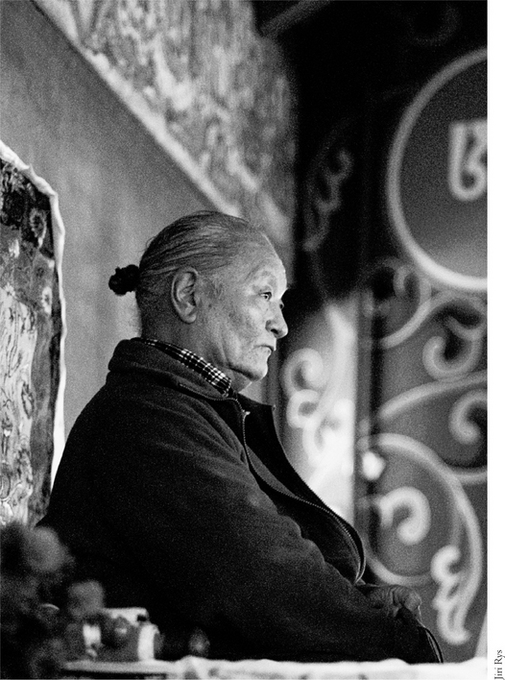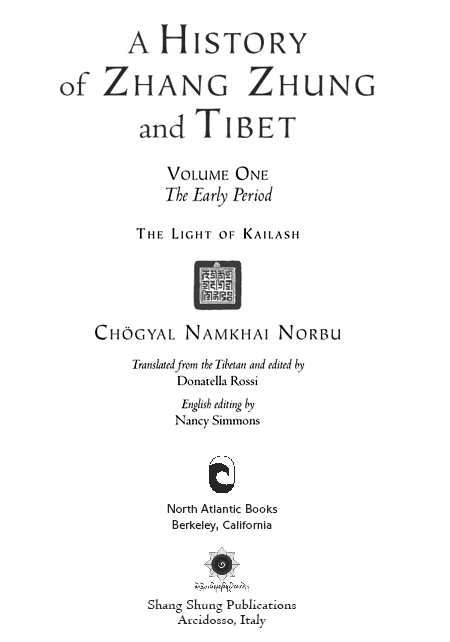Copyright 2013 by Chgyal Namkhai Norbu. All rights reserved. No portion of this book, except for brief review, may be reproduced, stored in a retrieval system, or transmitted in any form or by any meanselectronic, mechanical, photocopying, recording, or otherwisewithout the written permission of the publisher. For information contact North Atlantic Books.
Published by
North Atlantic Books
P.O. Box 12327
Berkeley, California 94712
www.northatlanticbooks.com
and
Shang Shung Publications
Localita Merigar
58031 Arcidosso (GR), Italy
www.shangshunginstitute.org
Cover calligraphy: Chgyal Namkhai Norbu
Cover and interior design: Daniel Zegunis
Layout: Tiziana Gottardi, graphics: Fulvio Ferrari
A History of Zhang Zhung and Tibet, Volume One: The Early Period is sponsored by the Society for the Study of Native Arts and Sciences, a nonprofit educational corporation whose goals are to develop an educational and cross-cultural perspective linking various scientific, social, and artistic fields; to nurture a holistic view of arts, sciences, humanities, and healing; and to publish and distribute literature on the relationship of mind, body, and nature.
North Atlantic Books publications are available through most bookstores. For further information, visit our website at www.northatlanticbooks.com or call 800-733-3000.
Library of Congress Cataloging-in-Publication Data
Namkhai Norbu, 1938
A history of Zhang Zhung and Tibet / Chogyal Namkhai Norbu; translated and edited by
Donatella Rossi; English editing by Nancy Simmons.
pages cm
Includes bibliographical references.
eISBN: 978-1-58394-626-8
1. Ngari Diqu (China)Civilization. 2. Ngari Diqu (China)History. 3. Zhangzhung languageChinaTibetHistory. 4. Bon (Tibetan religion)History.
DS797.82.N437N67 2013
951.5dc23
2013006207
IPC586EN09Approved by the International Publications Committee of the Dzogchen Community founded by Chgyal Namkhai Norbu.
v3.1
List of Tables
The Four Great Rivers
The Thirteen g.Yen of the Higher Sphere
The Nine g.Yen of the Intermediate Sphere
The Eleven g.Yen of the Earthly Sphere
Genealogy of the dMu Royal Lineage
gShen-rabs Consorts and Sons
The First sMe-khor
The Twelve Scattered Minor Principalities
Additional Principalities
C HGYAL N AMKHAI N ORBU (born 1938), former Professor of Tibetan and Mongolian Language and Literature at the University of Naples LOrientale, has dedicated his academic career to the study of Tibetan culture, and has published a number of works, in particular, on its origin. In his findings, the cradle of Tibetan culture is to be looked for in the ancient realm of Zhang Zhung and in the Bon spiritual traditions which flourished within and spread from that kingdom.
According to relevant textual sources, the ancient kingdom of Zhang Zhung, prior to the advent of Buddhism in the seventh century, encompassed a vast area including Western and Northern Tibet, with the revered and majestic Mount Kailash as its center and heart. Thus, the authors choice of title for his work is meaningful per se, in that it symbolizes and at the same time emphasizes the rich cultural origin of the Land of Snows.
Tibetan studies have a long and honored history, though only in the second half of the last century did scholars begin to take an interest in the Tibetan Bonpo culture. The reasons for this delay lie primarily in the previous lack of access to textual sources, and in the prevalence of orthodox Buddhist views which not only greatly influenced the attitude of modern Bonpo adherents, but have also been adopted by Western scholars as the unquestioned basis for the study of Tibetan culture as a whole, resulting in a simplistic view, still maintained by some, according to which Tibet was a savage land before the adoption of Buddhism, even lacking a written language.
Fortunately, a change in the status quo took place in the 1960s, when Prof. David Llewellyn Snellgrove invited a group of knowledgeable representatives of the Bon tradition
Soon after, Prof. Samten Gyaltsen Karmay published the translation of an outstanding work on the history of Bon, compiled by the famed Bonpo master and scholar, Shar-rdza bKra-shis rGyal-mtshan (18591934), which became a seminal text of reference for research studies;
During the 1980s, two sets of the Bonpo Canon (154 and 192 volumes, respectively) were reprinted in Eastern Tibet (present day Sichuan Province, Peoples Republic of China), while in the late 1990s, a collection of 300 volumes of ancillary texts (bka brten) of the Bonpo Canon was published in Lhasa by the Ven. Tenpai Nyima.
The availability of this extensive literature has paved the way for a series of analytic cataloguing, research studies, field work, seminars, and so on, that have contributed dramatically to improve understanding about the Bon tradition as a whole.Tibet can be considered a highly significant contribution to this body of knowledge.
The text was originally conceived as a set of university lectures that Chgyal Namkhai Norbu was invited to give at the University of Nationalities in Beijing (Minzu Daxue, former Zhongyang Minzu Xueyuan) in 1988. The contents of the lectures formed a first abridged version of A History of Zhang Zhung and Tibet, which was subsequently enlarged and expanded by the author after further research, until the manuscript, written in his unique calligraphy, became a work of 1,900 pages, divided in three volumes.
The first volume, The Early Period considers the rise of early human generations and the Bon lineages of ancient Zhang Zhung, its dynasties, language, and culture.
The second volume, entitled The History of the Intermediate Period: Tibet and Zhang Zhung, is focused upon human generations, the Bonpo lineages, the spread of Bon during the lifetimes of the first Tibetan monarchs, the dynasties, written language, and civilization of ancient Tibet, as well as upon the reigns of specific kings, the Bon religion, and Bonpo religious figures (Dran-pa Nam-mkha in particular) of Zhang Zhung during that period.
The third volume, The History of the Later Period: Tibet, is concerned with an assessment of the genealogies, Bonpo lineages, royal dynasties (from the first monarch, gNya-khri bTsan-po, until the forty-fifth monarch, Khri-dar-ma U-dum-btsan), language, and civilization of Tibet.
In the translators view, this summa of Chgyal Namkhai Nor-bus research is dedicated, first and foremost, to his fellow countrymen and women, and to Tibetan youth in particular. A History of Zhang Zhung and Tibet through meticulous selection and a critical use and analysis of a vast array of literary and often inedited sources, such as dynastic and religious histories and cycles, myths, articles, and so on, offers an open, daring, holistic, unbiased approach to the study of the cultural and spiritual heritage of Tibet and to the understanding of the origin of this fascinating and endangered civilization. It is my hope that scholars will appreciate the import, and interested readers enjoy the content, of this amazing trilogy.


